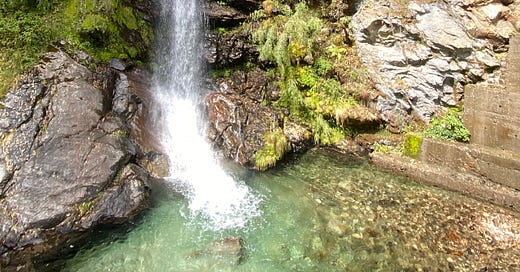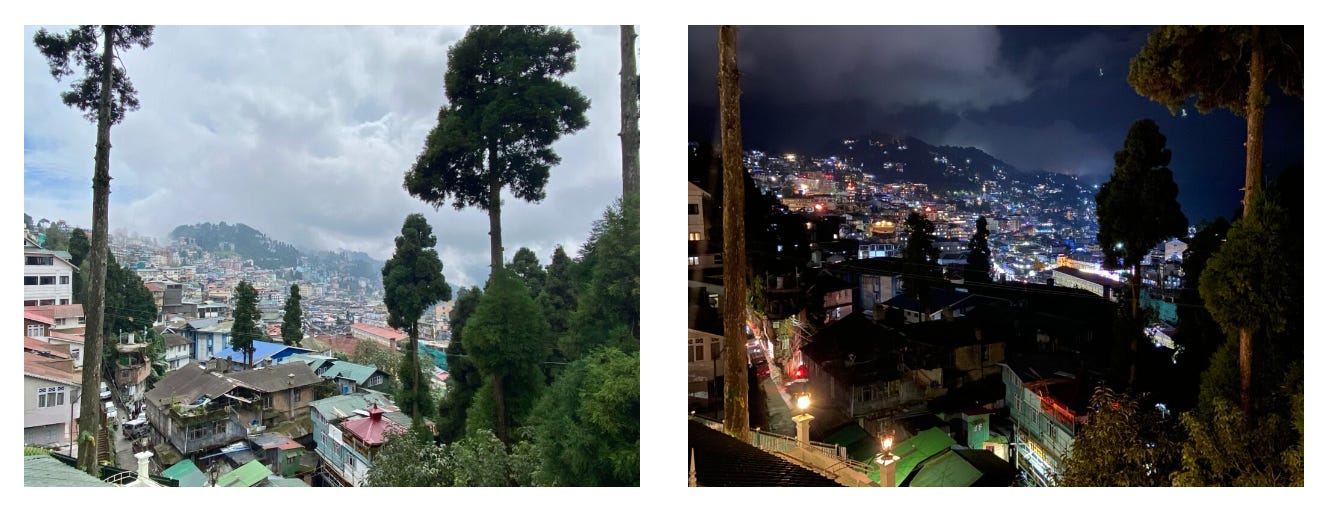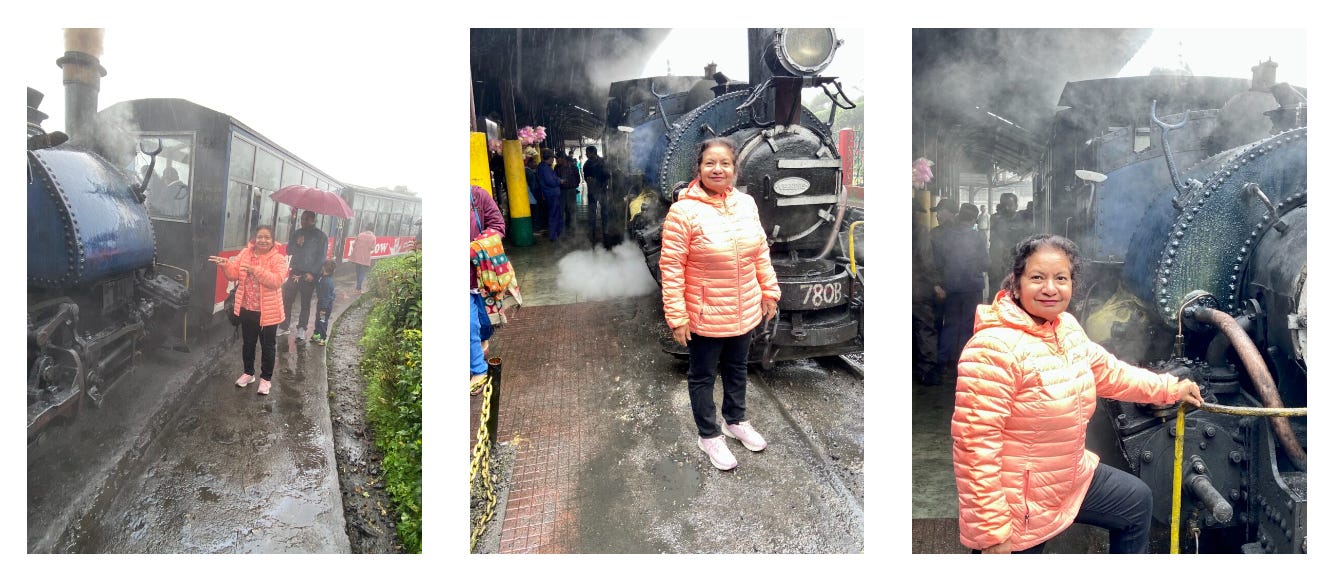At an altitude of 2,134 meters, Darjeeling was the jewel in the British Crown and is still known as the “Queen of Hill Stations” in India.
It was established as a sanatorium for British troops on the land ceded by the king of Sikkim to the British in 1835.
The name ‘Darjeeling’came from the Tibetan words, ‘dorje’ meaning thunderbolt and ‘ling’ a place or land, hence ‘the land of the thunderbolt’.
It is situated on a long, narrow mountain ridge of the Eastern Himalayas that descends abruptly to the bed of the Great Rangit River (a tributary to the Teesta river). I was told, that, on a clear day you can see Kanchenjunga and Mount Everest from a nearby viewing point.
But alas! The three days we were there were not clear at all.
We left Pelling early in the morning and after making a couple of stops at Pemayangtse Monastery (one of the oldest and premier monasteries of Sikkim) and the ruins of 17th-century Rabdentse Palace (Rabdentse was the second capital of Sikkim between 1670 to 1814), headed straight for Darjeeling.
It still took us the whole day to get there. Clouds decided to greet us at the hotel and stayed with us for the next three days. Since there was a bit of light, and our hotel was close to the Mall, we picked up the umbrellas (provided in each room) and went exploring the place.
The Mall is the place where locals come to soak in the sun and tourists come to shop. Most of the city’s old and heritage stores are lined here, along with the shed by small traders who were covering their merchandise with plastic. Rain seems to be the constant feature here so nobody seems to care.
We found a local bakery that had a queue waiting to get in. It must be good, we thought, and lined up too. We hadn’t had lunch and would have killed for a cup of tea. Thankfully we were in Darjeeling, the home of the most aromatic tea in the world. We had curry puffs and muffins and several cups of tea.
Later we found tea cafes that offered free tea tasting. Making a mental note to try them another day and made our way back to the hotel as we were supposed to wake up at four in the morning to go to Tiger Hill to see the sunrise and Kanchenjunga and Mount Everest if we were lucky.
The phone ran at quarter to four and I jumped out of the bed in fright. Who the hell was ringing so late at night? It was our guide. The rain had been bucketing all night and was still going on strong. “There was no point going to Tiger Hill but if you want I can still take you there,” said our guide. No way! I would rather sleep. We stayed in the bed till eight then had a shower and breakfast in leisure. No need to rush, it was still raining.
But our guide had other plans. He had booked us for the 9:30 toy train ride. Even though the station was a couple of kilometers away, it could take us an hour to get there because of traffic. Well, if you think you have traffic jams in big cities, you haven’t seen the traffic jam of a hill station. Roads are so narrow that only one car can pass through. So traffic from one side had to wait till the other side has gone through. Since everybody with a decent income has a car now means there are far too many cars that the old roads can handle.
Anyway, we got to the station in time, but the train was not ready. They were washing the carriage and shunting. The steam engine was nowhere to be seen. Once the train left precisely at 9:30 and it had a diesel engine. We were told it was going to Siliguri, a seven-hour ride through spectacular scenery.
Darjeeling Himalayan Railways was built between 1878 - 1881 to transfer commodities between the hills of Darjeeling and the plains. When it was built it pushed locomotive technology to the limits of relying on adhesion alone. The engineers at the time used techniques like loops and reverses to overcome the difficulties of the terrain, and narrow gauge and short wheelbase to allow for sharp radius in the line. It eliminated the need to make tunnels and bridges.
We boarded the train in the rain and even though we couldn’t enjoy the scenery we were delighted when the little steam engine huffed and puffed to get us to the height of 7,654 ft at the Ghum station.
Ghum station is the highest railway station in the world and it was listed as UNESCO World Heritage railway station in 1999.
We had our money’s worth when, on the way back, the train got stuck in the traffic, and we watched the train driver negotiating with (read yelling at) the vehicle drivers asking them to get out of the tracks. Where else in the world you will see a scenario like that!
Our next stop was at the Tibetan Self-Help Refugee Centre. Occupying 1000 acres, it was established in 1959 after the influx of millions of Tibates who followed Dalai Lama. Here inhabitants are free to protect their religion, culture of handicraft. They and sell carpets, thankas, wood-carved items, frames, wall hangings, bronze and copper pots, prayer wheels and leather boots.
But what touched me most was their museum. In two simple rooms, they had pictures and commentry, telling the story of how Tibetes lost their homeland.
We didn’t let rain it dampen our spirits and continued with our next excursion - Darjeeling’s Zoological park.
Darjeeling’s Zoological park owns the status of best Zoological Park in India and is internationally recognized for its breeding programs of Red Panda, Snow Leopards, Tibetan Wolves, and other endangered species of Eastern Himalaya. I finally got a glimpse of Snow Leopard which was curled up while the other leopard was sitting alert. Most of the other animals were either standing under trees or inside their shelter to escape the rain.
In the precinct of Zoological Park is also the Himalayan Mountaineering Institute. The institute was started by the Indian Government to commemorate the first successful ascent of Mount Everest by SherpaTenzing Norgay.
Living in the West most of my life, I was fed that Edmund Hillary was the first one to climb Mount Everest, but it was his sherpa, Tenzing Norgay who first set foot on the peak. It is one of the premier mountaineering institutes in the world. We visted museum and Tenzing Norgay’s grave. Unfortunately, photography was not allowed in the museum, otherwise I would have love to capture the stories of various expeditions also the massive diarama of Himalayan range indicating five highest peaks on earth.
I can keep going on and on with this newsletter but I must stop here. All good things come to an end. So did this trip. I spent the last week catching up with the family and first birthday of my sister-in-law’s first grandchild, which was as big as a wedding.
I come to believe that we Indians love to celebrate. We have festivals all through the year, and when there aren’t any there are weddings, birthdays, kirtans, satsangs and the list goes on and on.
This trip to India was special. For the first time in decades, I felt closer to my heritage. I could see the things I was missing out on - particularly the people and their quest for life, color, and festivities. But you only realize this when you are away from them for a while. When you are living in them, you don’t even notice them.
The trick is to travel a lot and experience different cultures.
That’s all from me this week.
If you liked this newsletter, please consider becoming a paid subscriber.











Wow!!! What a wonderful trip!!!! Tea and the Tibetan museum... ❤❤❤❤ Wow!!!